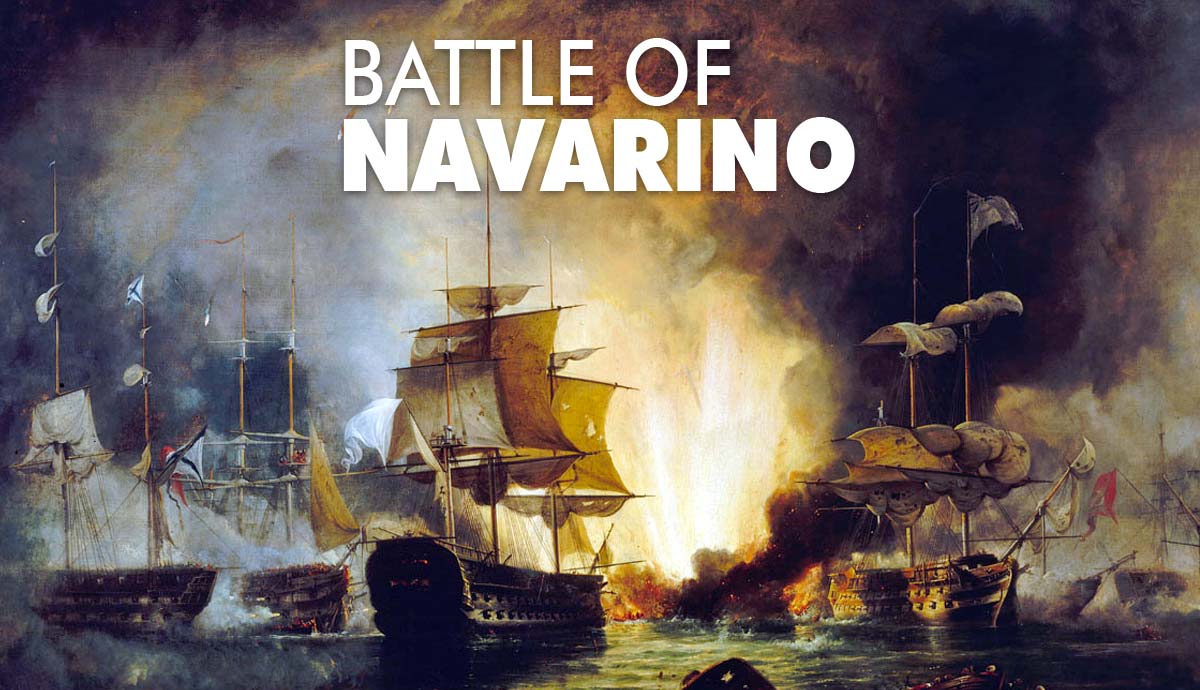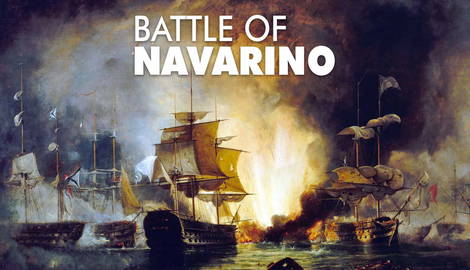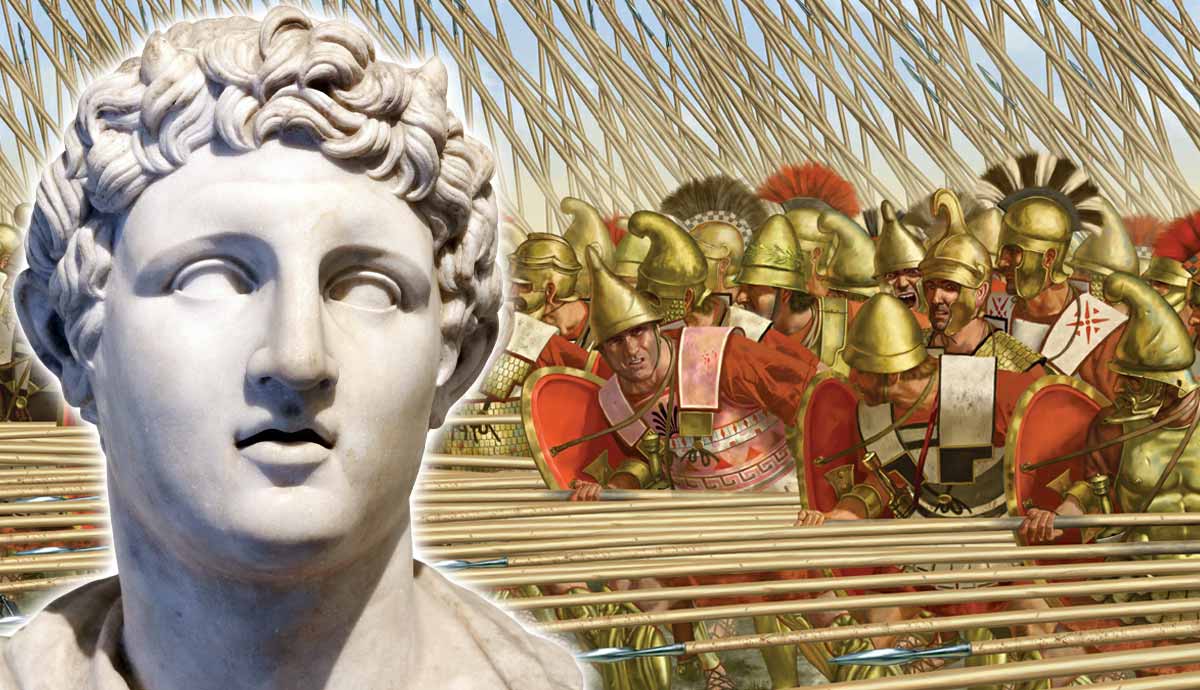
The Battle of Navarino on October 20, 1827 sits between two eras. As the first steam-powered ships took to the seas, two great masses of wooden sailing ships clashed in one last fleet action with the fate of an empire on the line. For a final time fleets of sailing ships impacted the course of history and secured the future of the new state of Greece. While Navarino was one of the 19th century’s most decisive battles, it resulted from indecision and unclear orders.
The Greek Cause

Since 1821 the Greeks had been conducting a rebellion against the Ottoman Empire. For years the rebel armies and navies fought the Ottomans to a standstill and began constructing a revolutionary state based on the models emerging in Western Europe and America. All the while the Greeks received only a tickle of uncoordinated support from the outside world. However, the Greek fighters were tenacious and persevered.
Realizing that they needed assistance to overcome Greek resistance, Sultan Mahmud II (1808-1839) looked to his nominal vassal Muhammed Ali of Egypt. The ruler of Egypt had built a formidable, European trained, military which his son, Ibrahim Pasha, transported to Greece in 1825. Immediately the war turned. Key towns such as Missolonghi and Athens fell and by early 1827 the Greeks were close to defeat.
Rebellions against the Ottomans were not new. Even when they involved the intervention of foreign powers they had never caught wider attention. In contrast, the Greek Revolution turned into a cause across Europe and America.

According to William St Clair, the Greeks revolted at a time when admiration for the culture and history of ancient Greece was at its highest. The Philhellenic movement that rose up to support the Greeks became the prototype of the modern international solidarity movement. Across Europe and America support groups formed to lecture, raise money, and lobby for the Greek cause. The most committed travelled to Greece to contribute or fight. The movement had its martyr when the most famous man of his day, Lord Byron, died in Missolonghi in 1824. As noted by historian Mark Mazower, by the mid-1820s support for Greece had grown across the political spectrum.
The governments of Europe were not unsympathetic but their policy was dictated by colder calculations. As the Greeks were launching their revolution constitutional and liberal movements were being repressed across southern Europe. The states which had survived the decades of the Revolutionary and Napoleonic Wars were not favorable to new revolutionary outbreaks. Furthermore, an intervention in the Ottoman Empire threatened the balance of power of the whole continent. Weakening the Ottomans could produce a scramble for influence and land across the eastern Mediterranean. In such a scenario the post-Napoleon peace would prove very short.
The Road to Intervention
From 1825 the conservative fear of revolution was gradually overcome as a mixture of anxiety and calculations drew Britain and Russia into the conflict.
As fellow Orthodox Christians the Greeks looked to the Russians for aid from the very beginning. Russia had supported Greek revolts in the 18th century and styled itself as the protector of Orthodox Christians. Indeed, the belief that the Tsars supported the cause was a key factor in the promotion of the revolution.
Britain was in a sense already involved. The nascent Greek state was funded by two loans raised in London. These were acts of private individuals rather than the British state but they demonstrated a high level of British interest. The consideration weighing on British policy was that if the Russians were to intervene they could not be allowed to do so alone lest they take on too large a role in the region. Moreover, there was a way to turn any intervention to Britain’s advantage. By supporting Russian moves in Greece Britain would achieve one of its aims in weakening the Russian alliance with Austria and Prussia who opposed assistance to revolutionary Greece.

The worry that tipped the balance in 1825 was the intention of the Egyptian forces which were gradually defeating the Greeks. Should Ibrahim’s army triumph, it was believed the Egyptians would depopulate and resettle Greece in a form of ethnic cleansing. This threat allowed the Great Powers to present their coming intervention not necessarily as taking a side in a conflict but as an act upholding standards of behavior and preventing a barbaric policy.

The Anglo-Russian moves led to the Protocol of St Petersburg in 1826. Under this plan Greece would become, not an independent state, but an autonomous vassal of the Ottomans after Anglo-Russian mediation. However, the Sultan understandably saw the calls to stop the fighting as interference in internal Ottoman affairs and rejected all attempts at mediation. A year later France joined Russia and Britain in signing the Treaty of London in July 1827. Again the Great Powers called for the fighting to end and for the creation of a semi-independent Greece. Should the Sultan refuse this mediation the allied fleets already in the Mediterranean or on route would force an end to the war.
Enforcing Peace
Three of Europe’s Great Powers had now decided to end the war in Greece. The Ottomans and Ibrahim Pasha could only see this as a one-sided intervention to settle a conflict they were about to win. The British, French and Russian admirals that were to enforce this peace had unclear instructions on how to implement their orders. The admirals were sailing into the middle of a conflict but their mission was to end a war, not get involved in one. The outcome of this vagueness was the Battle of Navarino.
The allied forces that assembled in the summer of 1827 were led by three experienced admirals. Taking overall command was the British admiral Sir Edward Codrington who had participated in the Battle of Trafalgar. The French fleet was led by Henri de Rigny who had fought on the other side of the Napoleonic War. The Russian fleet, under the experienced Dutch officer van Heiden, arrived at the end of summer to complete a large and veteran force.

The campaign quickly centred on the Ottoman and Egyptian fleets based in the south-west Peloponnese. The allies sought to prevent the fleet from leaving the area and launching an attack on the island of Hydra, the last remaining centre of the Greek fleet. When the allied admirals met with Ibrahim at the bay of Navarino it was agreed that operations would halt while new orders were awaited from the Sultan.
From the beginning, the Ottomans saw the allied intervention as one-sided. The Greeks had accepted an armistice but the Sultan and Ibrahim had not. Yet, the allies seemed to be allowing the Greeks to continue the fighting while preventing the Ottomans from responding. In late September Greek ships, under the command of a volunteer British commander, were allowed to attack and defeat an Ottoman squadron at Itea. For Ibrahim, this was a clear breach of the armistice but when he tried to send out ships in response Codrington blocked him and accused the Ottomans of being the aggressors.
Distrust between Codrington and Ibrahim was growing. The situation deteriorated again at the start of October. Not long after the Russian squadron arrived to complete the allied fleet Ibrahim sent his troops to raid the countryside around the town of Kalamata. The destruction and burning looked to the allies as proof that Ibrahim could not be trusted and that a campaign to devastate and depopulate the land was underway.

The allied admirals decided to sail into Navarino Bay where the Ottoman-Egyptian fleet was stationed. They were still not at war with the Ottomans and the ambiguity of their mission to enforce peace remained. The admirals seem to have hoped that by sailing into Navarino they could force Ibrahim to withdraw from the Peloponnese without opening fire. If that did not happen the allies would find themselves in very close proximity to a very large fleet.
Sailing Into Navarino Bay
Navarino Bay is one of the best natural harbors in the Peloponnese. At three miles (five kilometers) long by two miles (three kilometers) broad it was large enough to comfortably contain a combined Ottoman fleet of more than 80 ships. With the bay almost entirely closed off by the long, narrow island of Sphacteria, Codrington’s fleet of 27 ships was sailing into a dangerous position.
The Ottoman fleet was more than twice the size of the allied force. Its 2,100 guns and 20,000 sailors considerably outnumbered the 1,300 guns and 17,500 sailors of the allies. While numerous, the Ottoman ships were generally smaller and lighter and the allies possessed more of the key line of battleships with ten compared to their opponent’s three. Ibrahim’s forces, however, had been trained by French officers as part of Muhammed Ali’s modernization program. It was only in the days before the battle, as a French fleet rapidly approached, that these advisors were withdrawn. Despite this training, the allied fleet had the edge due to its experience. With twelve British ships forming the largest contingent, followed by eight Russian and seven French vessels, this was one last great fleet led by the British at the height of their naval supremacy.

Just before they withdrew Ibrahim’s French officers prepared the Ottoman fleet to receive a possible allied attack by drawing it up in horseshoe formation constituted by three lines. At the edge of the lines were fireships, disposable vessels meant to be set alight and sailed into the enemy formation. With additional fortifications on land and on Sphacteria the Ottoman fleet was in a position to fight, not sail away. The allies risked being caught in the middle of the bay under a hail of fire.
An “Untoward Event”
In the early afternoon of October 20th, Codrington led the way into Navarino on his flagship Asia followed by the remaining British contingent. Next into position were de Rigny and the French with van Heiden’s Russian squadron entering the bay last.
Though the two fleets were now face to face in the crowded bay no shots had been fired. However, when Codrington refused to stop his manoeuvre the Ottomans seemed to be preparing to launch one of the fireships. The British officers who attempted to prevent this were fired upon and soon shots were ringing out on both sides. It was not just the allied fleet that was working under ambiguous orders. The Ottoman commander Tahir Pasha had ordered that while he would not start a battle his ships were to respond if attacked. Both sides were fully prepared to fight but it seems neither intended to unless necessary. Once the first shots were fired it became impossible to stop a battle from developing.

Once the battle was underway the more disciplined and accurate firing of the allied fleet made the difference. The fighting raged at close quarters from around 2 pm to 6 pm. This was not a battle of maneuvers or positions. The two fleets blasted away at the ships opposite them until they were sunk or surrendered. At the end of it, two-thirds of the Ottoman fleet had been destroyed and thousands of sailors killed or wounded. On the allied side, around 180 were reported killed and 500 wounded with several ships badly damaged but not lost. Throughout the night Ottoman ships continued to burn as some damaged ships were deliberately destroyed.
In the aftermath of the battle, Ibrahim withdrew what was left of the fleet back to Egypt. The Greek war would not finally end for a few more years but after Navarino, its result was not in doubt. The battle had been decisive but the fact there had been a battle at all was not welcomed in the allied capitals. Codrington had been dispatched to enforce an armistice, not destroy the fleet of a state Britain was not at war with. Far from celebrating the battle King George IV famously described it as an “untoward event” and Codrington in particular was blamed for exceeding his orders which had at best been unclear and at worst simply wishful thinking.
End of the Age of Sail

Though it had been almost an accident, Navarino was the last large-scale battle between fleets of sailing ships.
Already the signs were visible. The first experiments with steam-powered ships took place in the early 19th century and when adventurous and far-sighted British sailors such as Frank Abney Hastings and Thomas Cochrane made proposals to the Greeks they suggested trusting steamships to win the war. Though a full force of steam-powered ships never made it to the Greek conflict, one of the first such ships to enter service, the Karteria, did have an impact. In the engagement at Itea, which had provoked Ibrahim, the Karteria destroyed 9 Ottoman vessels. A new mode of warfare was on its way.
Bibliography
Brewer, D (2001). The Greek War of Independence: The Struggle for Freedom from Ottoman Oppression and the Birth of the Modern Greek Nation. Overlook Press. Woodstock N.Y
Finlay, G (1861). The History of the Greek Revolution. Volume II. William Blackwood and Sons. London
St Clair, W (2008). That Greece Might Still be Free: The Philhellenes in the War of Independence. Open Book Publishers. Cambridge
Mazower, M (2021). The Greek Revolution. 1821 and the Making of Modern Europe. Allen Lane. Milton Keynes







